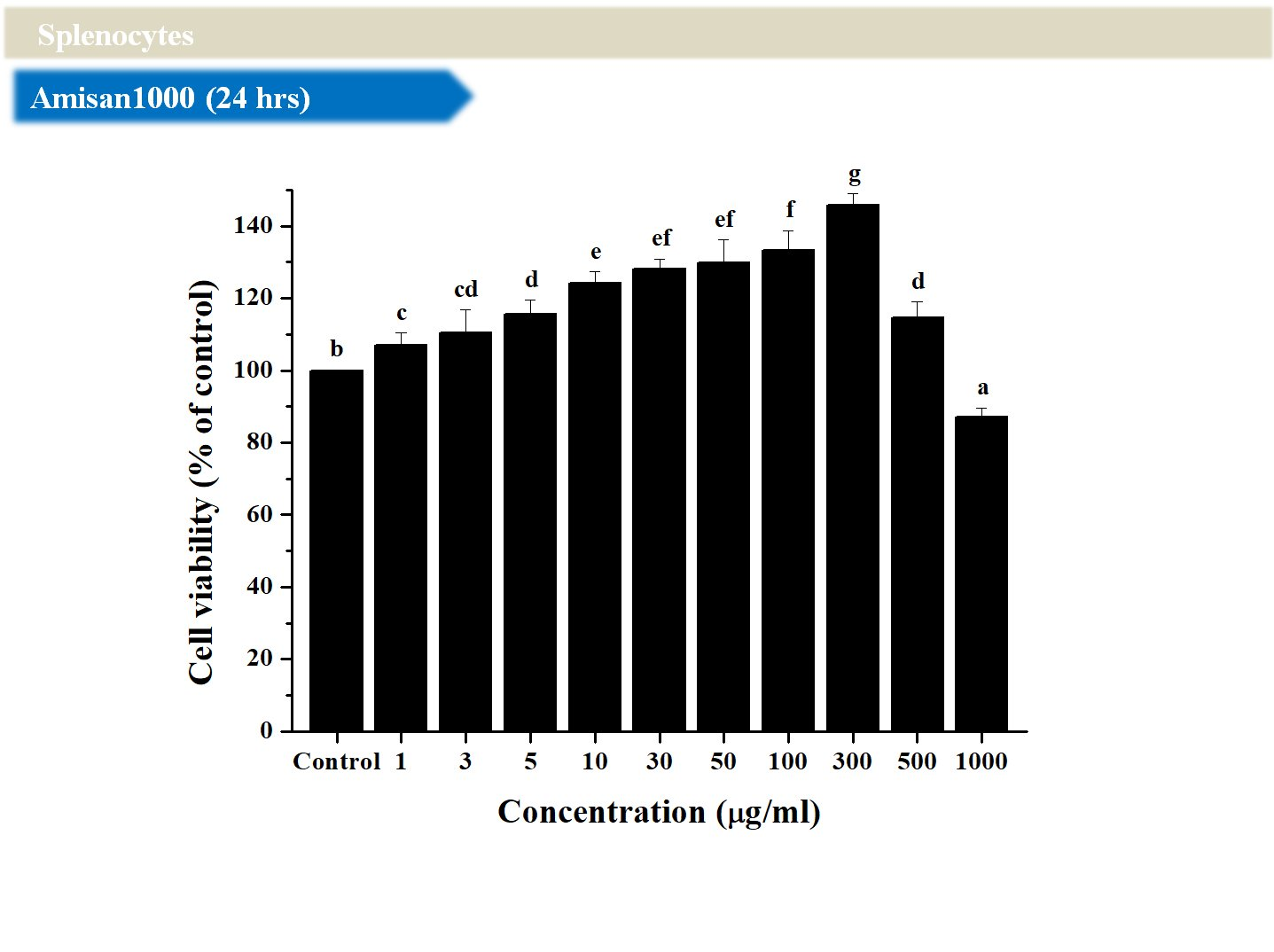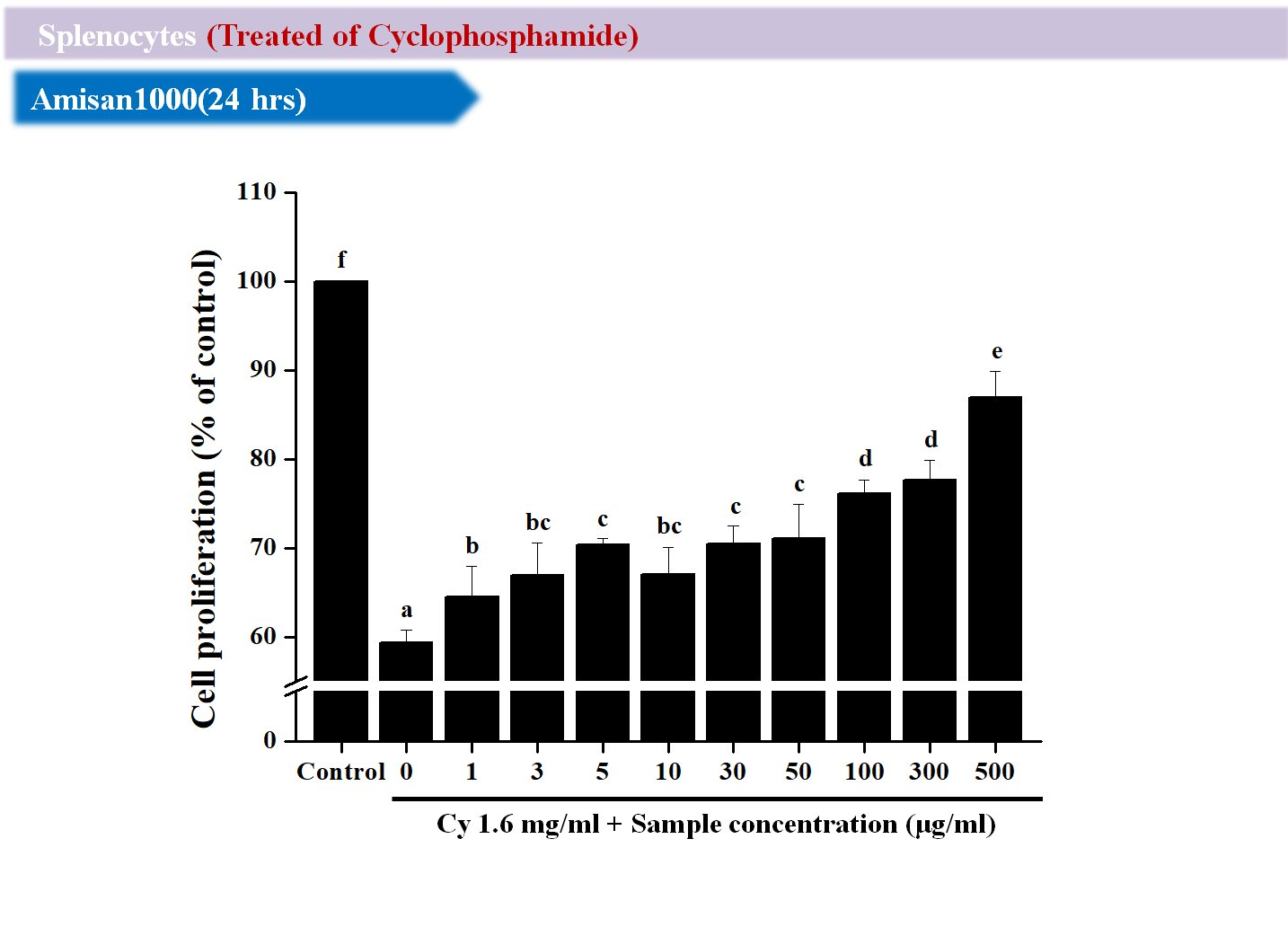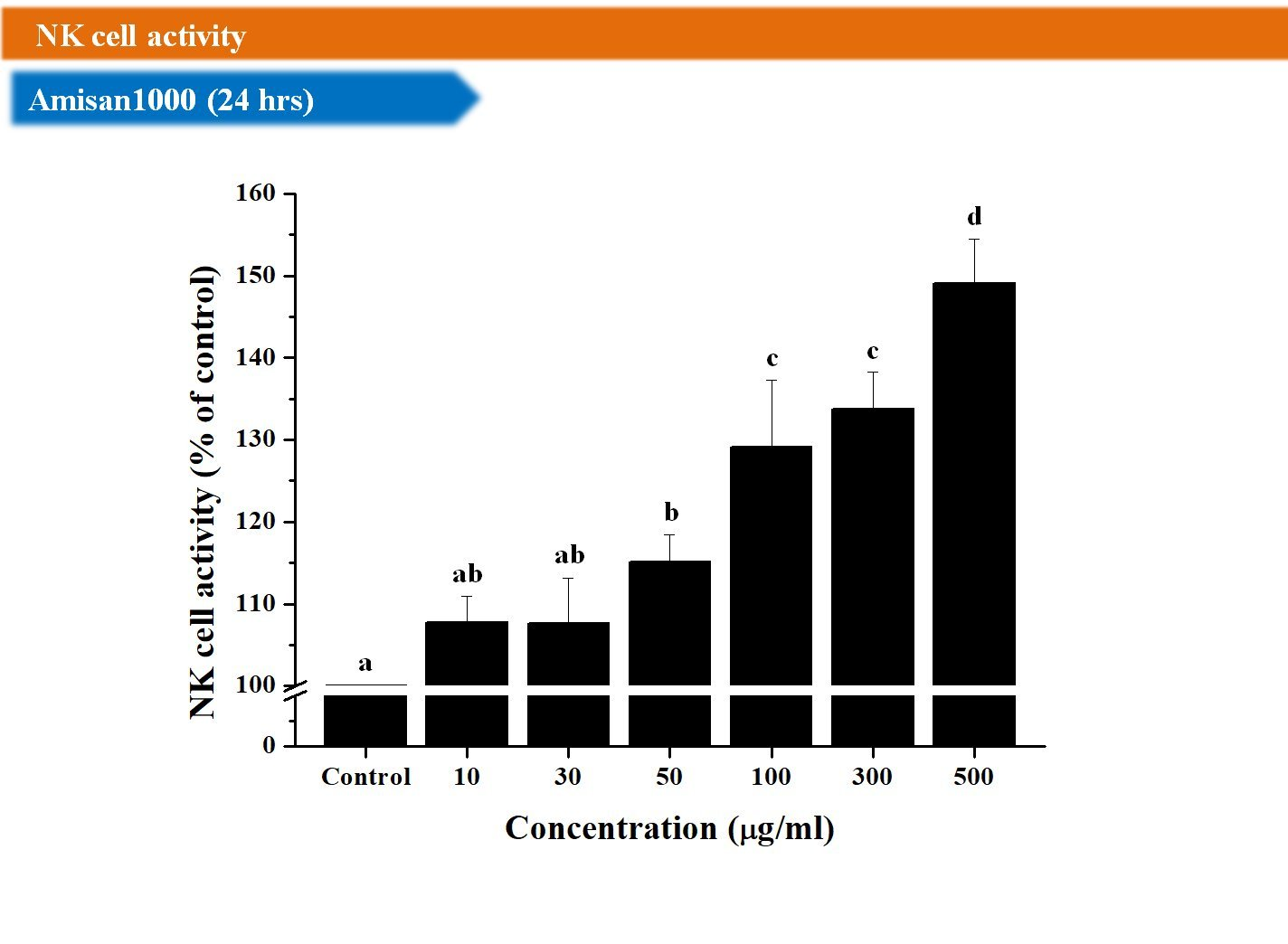Amisan1000(Livestock)
Ohsung Bio Co. Ltd. “Precious human life and harmony with nature”

Amisan-1000(Brand new/Innovative Booster)
"Amisan-1000" is including the specialized & Innovated Immunity substance, in order to reinforce the Immunity in the Livestock.
As an auxiliary feed of optimizing amino acid composition, Feed Palatability is increased, the Digestion Rate is improved, and the Growth Rate is improved.
Amisan-1000 is a liquid supplementary feed produced through technology of optimizing essential amino acids composition that we have learned by a research and development for a long time, and this product is produced with herbal medicines ingredient that we have gained through know-how from field experience for many years.
As this product used of L-lysine, an essential amino acid, as main ingredient, so disease condition of a sick pig and an atrophied pig is improved rapidly through immunity enhancement in case of feeding for livestock.
In addition, by decreasing stress and increasing feed palatability, we can expect heath improvement effects as an increase of appetite, and a death rate decreases because this product prevents diseases from virus and bacteria.
Also, by decreasing side effects of vaccines and antibiotics, we can anticipate environmentally friendly livestock farming management.
Recently the Importance of supplementary feed has been highlighted as time goes by, as the growing reluctance of customers for pork used antibiotics.
In modern livestock farming, the raising large number of livestock in intensive conditions has led to the use of antibiotics for treatment and prevention of diseases.
However, due to the fact that antibiotics can harm humans who consume meat for various reasons in spite of great effect of antibiotics, as a result, domestically regulations on antibiotics have been tightened, and therefore antibiotics are not being used in the mixing feed currently.
For this reason, because antibiotics are not used, many diseases break such as PRRS, respiratory diseases etc, and we are making great efforts to develop antibiotic substitute.
As this supplementary feed of our company is to improve health and immunity of livestock, and to be helpful for productivity increasing, it is being introduced to modern livestock farms as a new feed additive.
- Efficacies and Effects
- - Rapid recovery of a sick pig or an atrophied pig on account of immunity improvement.
- - Strengthening Immunity and relieving stress due to the supply of essential amino acids.
- - Improving growth rate in case of feeding this supplementary feed together with water to a weaning piglet due to proper combination of essential amino acids.
- - Decreasing death rate by less than 4 % to 5 % in case of raising from weaning piglets to 70-day-old pigs.
- - Reducing mortality rate by less than 2 % to 3 % in case of raising from 70-day-old pigs to raising pigs till shipment day.
- - Growth normally through decreasing a rate of occurrence of PMWS disease in case of raising from weaning piglets to swine of 30kg weight.
- - Activation of metabolism in the body due to increase of intestinal effective microorganisms.
- - facilitating return of estrus in sows after weaning, and increasing suckling piglets weight due to milk of pig increase of sows that farrowed.
- - Reducing digestive diseases due to improving digestive absorption rate of weaning piglets.
- - Strengthening resistance to disease and decreasing mortality rate due to prevent of bacterial and virus invasion.
- - Faster shipping schedule of non-fat pigs and greater feed efficiency.
- Productivity of Amisan-1000
- - Maximizing feed additive effect due to watering together with this product.
- - It is easy to protect the original technology and to enlarge the supply of raw materials, because of being made by domestic technology.
- - It is easy to purchase again on account of added value increasing due to the effect of productivity improvement of livestock farms.
- - Environmentally friendly livestock farming management is possible as result of the effect reducing overdose of vaccines and antibiotics.
- - This company was picked up to beneficiary of main industrial enterprise support service (non-R&D) in Chung Nam region in 2017 and with taking the support of Soon Cheon Hyang University, the effect and efficacy of this product was proved through the specifications test being done by a certified organization.
- I. Effects of the supply of Amisan-1000 on the growth rate, feed intake volume, FCR (Feed Conversion Rate) in weaning piglet
- When a test was started, 21-day-old 40 weaned piglets that were a ternary hybrid [Land-race x Yorkshire x Duroc] of the weight of 6.28kg ~6.86kg was selected randomly and it was done a field test for 30 days. The field test was conducted at a commercial swine farm of 10,000 sows in Gochang Gun region.
- It consisted of 20 pigs per group, and it was grouped into test group and control group to be divided room.
A used feed is a feed of weaning piglet made by P company (a new born piglet feed 1 step), and both test group and control group piglets had eaten that feed freely.
Test group was watering by diluting 1L of Amisan-1000 together with 1 ton of water, and control group was watering normal water freely.

Table 1. Effects of Amisan-1000 on growth rate, feed intake, feed conversion rate in weaning piglet
| Items | Control group | Amisan-1000 group |
| Initial BW (g) Final BW (g) ADG (g) DFI (g) FCR |
6.59 16.75 362 586 1.62 |
6.48 17.98 410 632 1.54 |
Table 2. Effects of Amisan-1000 feeding on blood chemical properties in weaning piglet
| Items | Control group | Amisan-1000 group |
| WBC, 103/ul RBC, 106/ul HGB, g/dl HCT, % MCV, fl MCH, pg MCHC, dl PLT, 103/ul IgG, mg/dl | 21.48 6.68 9.85 30.75 46.23 14.61 32.48 328.2 225 |
24.83 6.97 10.58 32.49 47.45 15.17 32.88 425.5 284.6 |
Average Daily weight Gain (ADG) increased in Amisan-1000 group (410g) compared to control group (362g). In case of Daily Feed Intake (DFI), Amisan-1000 group (632g) increased a little bit in comparison to control group (586g), but Feed Conversion Rate (FCR) increased greatly as a result in Amisan-1000 group (1.62) compared to control group (1.54).
Feed intake increasing was caused by immunity improvement, feed conversion rate improvement was caused from increase of digestive absorption rate by functional, physiological active substance in Amisan-1000.
In the result of Blood Properties Analysis (Complete Blood Count) & Ig G Content Analysis, Amisan-1000 group increased Leukocyte (White Blood Cell) and Ig G, and concentration of Erythrocyte (Red Blood Cell) increased, so overall blood circulation improvement effect appeared.
Increasing Ig G, an immunoglobulin, indicated activation of cells responsible for humoral immunity, suggesting that Amisan-1000 increases antiviral resistance against viruses.
This may solve the problem of PRRS disease which is a problem in young weaning piglets.
- II. Increasing effect of pregnancy rate in sows
-
The following table is a table of pregnancy rates of a livestock farm that has been suffering from continuous pregnancy rate decrease since 2016. This is the case that a pregnancy rate increased after 30 days from starting feeding of Amisan-1000 in October 2018.
Table 3. Increase in pregnancy rates after feeding of Amisan-1000 (January 2016 ~ December 2018)
2016 Pregnancy Count/ Breed count Pregnancy rate 2017 Pregnancy Count/ Breed count Pregnancy rate 2018 Pregnancy Count/ Breed count Pregnancy rate Jan. 18/22 81.82% Jan. 24/30 80% Jan. 16/24 66.67% Average
before feeding
(Jan.~Oct.)
71%Feb. 26/31 83.87% Feb. 17/34 50% Feb. 34/40 85% Mar. 37/45 82.22% Mar. 37/51 72.55% Mar. 18/23 78.26% Apr. 12/13 92.31% Apr. 16/21 76.19% Apr. 26/34 76.47% May. 25/31 80.65% May. 34/51 66.67% May. 19/26 73.08% Jun. 27/36 75% Jun. 24/31 77.42% Jun. 13/19 68.42% Jul. 26/31 83.87% Jul. 15/25 60% Jul. 30/39 76.92% Aug. 20/31 64.52% Aug. 20/33 60.61% Aug. 23/40 57.50% Sep. 24/30 80% Sep. 21/28 75% Sep. 16/25 64.00% Oct. 18/21 85.71% Oct. 27/37 72.97% Oct. 27/39 69.23 Nov. 22/36 61.11% Nov. 33/45 73.33% Nov. 27/30 90% Average
after feeding
89%Dec. 24/34 70.59% Dec. 20/28 71.43% Dec. 29/33 87.88% An upper table indicates that pregnancy rates, from which averaged 78% in 2016 and 70% in 2017, and 71% in October 2018, increased until more than 87% after feeding Amisan-1000 since October 2018.
- III. Weight gain after feeding Amisan-1000 for pigs during 2 months (60 days)
-
The test group was feed through diluting 1L of Amisan-1000 with 1 ton of water.
Table 4. weight gain table after feeding Amisan-1000
The upper table indicates that average weight of pigs increased more than 4.6kg in comparison to before feeding after feeding during 60 days.Test period Total weight (kg) Pigs Count Average weight (kg) Condition Remarks 25 July 2017 ~ 26 Sep 2017 29.050 1,100 26.41 -before feeding 24 Oct 2017 ~ 12 Dec 2017 22.330 810 27.56 -during feeding 1.15kg weight gain 26 Dec 2017 ~ 6 Feb 2018 32.160 1,050 31.05 -after feeding 3.5kg weight gain Source : Test result of swine farm having 10,000 pigs count
- IV. Weight gain of 4-week-old weaning piglets in case of being fed Amisan-1000
-
Table 5. Weight gain example of 4-week-old weaning piglets in case of being fed Amisan-1000 [The Data in 2019]
Date Swine Count Total weight (kg) Average weight (kg) Remarks 14 Mar.
21 Mar.
28 Mar.
04 Apr.
11 Apr.
18 Apr.
25 Apr.
02 May
09 May
16 May
25 May
207
209
198
210
235
212
260
245
240
190
242
2005.8kg
2092.8kg
1817.6kg
2129.4kg
2305.4kg
1975.8kg
2399.8kg
2205.0kg
2354.4kg
1710kg
2524kg
9.69kg
10.11kg
9.18kg
10.14kg
9.81kg
9.32kg
9.23kg
9.00kg
9.81kg
9.00kg
10.43kg
* Average weight of 4-week-old weaning piglet in South Korea is 5.5kg~6.5kg
- V. Weight gain of 7-week-old weaning piglets in case of being fed Amisan-1000
-
Table 6. Weight gain example of 7-week-old weaning piglets in case of being fed Amisan-1000 [The Data in 2019]
Date Swine Count Total weight (kg) Average weight (kg) Remarks 28 Mar.
04 Apr.
11 Apr.
18 Apr.
23 May.204
198
210
205
240
3616.9kg
3752.1kg
3853.5kg
3599.8kg
4699.0kg
17.73kg
18.95kg
18.35kg
17.56kg
19.58kg
- VI. 10-week-old (70-day-old) weaning piglets in case of being fed Amisan-1000
-
Table 7. Weight gain example of 10-week-old (70-day-old) weaning piglets in case of being fed Amisan-1000 [The Data in 2019]
Date Swine Count Total weight (kg) Average weight (kg) Remarks 4 Apr.
11 Apr.
18 May
204
198
204
6721.8kg
7078.5kg
6940.0kg
32.95kg
35.75kg
34.02kg
* Average weight of 10-week-old (70-day-old) weaning piglet is 26kg in South Korea : 26kg
- VII. shipment date in case of being fed Amisan-1000 during 60 days after weaning
- - First shipment age : 150 days
- Average shipment age : 160 ~ 170 days
- * Average shipment age in South Korea : 202 days
- VIII. Effects on Productivity and Immunity Enhancement in broiler in case of feeding of Amisan-1000
-
12,000 male chick counts of 1 day-old broiler (Ross x Ross 308) were selected, and that the test conducted for 32 days at the beginning of the stage of broiler (0~3 weeks) and the end of the stage of broiler (3~5 weeks). The test field place is a broiler farm in Jeong-Eup City in South Korea.
A test group and a control group were seperated and bred in two general cage-free hen houses with 6000 counts of chick respectively. A forage was Cheonha-Jaeil-Feed, which was fed at the beginning of the breeding stage of broiler and the end of the breeding stage of broiler. Both the test group and the control group were given free feeding. The test group was fed through diluting 1L of Amisan-1000 per 1 ton water, and the control group drank general water freely.Table 8. Effects of Amisan-1000 on growth rate, feed intake, feed conversion rate in broiler
Items Control group Amisan-1000 group Initial BW (g)
Final BW (g)
BW gain (g)
Feed intake (g)
FCR42
1,612
1,570
2,744
1.6142
1,665
1,623
2,789
1.60Table 9. Effects of Amisan-1000 on leukocyte, erythrocyte, lymphocyte, Ig G in broiler
Items Control group Amisan-1000 group WBC, 103/ul
RBC, 106/ul
Lymphocyte, %
IgG, mg/dL288.6
2.12
82.3
1.27297.3
2.19
82.5
1.35In broiler experiments, the weight gain indicated a tendency to increase in the test group of being fed Amisan-1000(1,665g), compared to the control group (1,612g).
Source : Analysis result report on productivities and immunity enhancement effects assessment of Amisan-1000 in piglets and broilers. (by INVIVO Research Company, 2017)
And, the feed intake indicated a tendency to increase in the Amisan-1000 group (2,798g) in comparison to the control group (2,744g).
Also, Feed Conversion Rate (FCR) has a significantly improved a little in Amisan-1000 group (1.61) in comparison to the control group (1.60).
The effects on blood properties also showed some improvement in leukocyte, erythrocyte, lymphocyte, Ig G content.
The test on the effect of Amisan 1000 for immunity enhancement - tested by INVIVO Research Company
- 1. Splenocyte viability rate test
Spleen has immune response to antigens in blood, so splenocyte proliferation is relevant to immune responses and the size and the number of splenocyte are used as important immunity index.
Immunity-stimulation studies of Amisan 1000 showed that the splenocyte cell viability for Amisan 1000 was not cytotoxic up to the concentration of 1000 ug/ml.

Figure 1. Effect of Amisan 1000 on splenoctyes viability - 2. Cell proliferation test of splenocytes treated with Cy
The control group treated only with cyclophosphamide (Cy), one of the most commonly used alkylating agents as anti-cancer or immunosuppressive agents,
showed a significant decrease in the proliferation rate of splenocytes by 56~59% after 24 hours.
On the other hand, the test groups treated with Amisan 1000 after treated with Cy1.6mg/ml showed splenocyte proliferation rate of 84.1~89.9% at the concentration of 500 ug/ml in 24 hrs, compared with control.

Figure 2. Effect of Amisan 1000 on splenocytes proliferation rate treated with Cy.- 3. NK cell activity test One of the innate immune responses, NK cells, recognize cells infected with viruses, tumor cells, abnormal cells, and target cells to induce apoptosis by the secretion of cytokines.
In the test group treated with Amisan 1000, NK cell activity rate was increased to 143.7~154.5% at the concentration of 500 ug/ml in 24 hrs, compared with control.

Figure 3. Effect of Amisan 1000 on NK Cell activity
- - Results
In these experiments treated with Amisan 1000, the increasing in the splenocyte proliferation and NK cell activity were indicated potent immunity enhancer effects.
Therefore, these results suggest that these products could be expected a promising improvement strategy for immunological enhancement. - 3. NK cell activity test One of the innate immune responses, NK cells, recognize cells infected with viruses, tumor cells, abnormal cells, and target cells to induce apoptosis by the secretion of cytokines.


308, 3F, 226, Sandan 3-gil, Sapgyo-eup, Yesan-gun, Chungcheongnam-do, Republic of Korea
Tel. 82-41-337-3881 | Fax. 82-41-337-3882 | E-mail. ohsung1703@naver.com
Copyright © ohsungbio. All Rights Reserved.